5.4.3. DEVELOPMENT APPLICATIONS.
This category of applications includes those applications that do not require rezoning, subdivision, or other approvals under this UDO.
A. Conditional Use. All applicable provisions of Section 146-5.3 (Common Procedures) apply unless specifically modified by the provisions of this Section 146-5.4.3.A.

1. Applicability.
a. This Section 146-5.4.3.A applies to all applications for a use listed as a conditional use in Table 0-1 (Permitted Use Table) or for a use listed as a listed as a “V” use in Table 0-1 if the application is filed after the primary building on the property has been vacant for five years or more. Uses listed as conditional uses or “V” uses are only allowed if approved pursuant to this Section 146-5.4.3.A.
b. A conditional use approval is only valid for the location stated in the application, and cannot be transferred to a new location.
c. If an approved conditional use is discontinued for a period of one year or more, it may not be reestablished without approval of a new conditional use application.
2. Procedure.
a. The Planning Director shall review the application and forward a recommendation to the Planning and Zoning Commission pursuant to all applicable provisions of Section 146-5.3 (Common Procedures).
b. The Planning and Zoning Commission shall conduct a public hearing on the application and shall make a decision on the application pursuant to all applicable provisions of Section 146-5.3.
3. Criteria for Approval. A conditional use shall be approved only if the Planning and Zoning Commission determines that:
a. The application complies with the applicable standards in this UDO, other adopted City regulations (including but not limited to any use-specific standards for the proposed conditional use in Section 146-3.3), any approved Master Plan that includes the property, and any conditions specifically applied to development of the property by the Planning and Zoning Commission or City Council in a prior decision affecting the property;
b. The application is consistent with the Comprehensive Plan;
c. The size, scale, height, density, multi-modal traffic impacts, and hours of operation of the proposed use are compatible with existing and planned uses in the surrounding area;
d. The proposed use will not change the predominant character of the surrounding area;
e. The City's existing infrastructure and public improvements, including but not limited to its street, trail, and sidewalk systems, have adequate capacity to serve the proposed development, and any burdens on those systems have been mitigated to the degree practicable; and
f. The application demonstrates that the proposed use will not create significant dislocations of tenants or occupants of the property, or that any impacts are outweighed by other public benefits or progress toward other Comprehensive Plan goals that would be achieved by approval of the application.
g. The application mitigates any adverse impacts on the surrounding area to the degree practicable.
B. Site Plans. All applicable provisions of Section 146-5.3 (Common Procedures) apply unless specifically modified by the provisions of this Section 146-5.4.3.B.
1. General Requirement.
a. A Minor or Major Site Plan complying with this Section 146-5.4.3.B is required before a building permit may be issued for all development in the City except those listed below:
i. Single-family detached homes on lots in a subdivision of three or fewer lots and that are not a part of land for which a Master Plan has been approved.
ii. Permitted additions to existing single-family detached dwellings.
iii. Non-habitable accessory structures (not including Telecom Facilities and Major Utilities facilities) that have no significant external effects on adjacent lands as determined by the Planning Director.
iv. Minor changes in architectural façade treatments, or architectural changes to buildings approved without architectural elevations, that qualify as administrative adjustments under Section 146-5.4.4.F.
v. Park facilities that are developed pursuant to a parks master plan approved by the City.
vi. Facilities owned or operated by the City that do not include habitable structures and do not require any personnel on site to operate or provide services from the facility (except for maintenance or repairs of the facility).
vii. Interior improvements and tenant finish.
b. In those circumstances where a Master Plan approval is required pursuant to Section 146-5.4.1.E (Master Plan), no Site Plan may be approved before a Master Plan is approved for the proposed Site Plan area.
c. Approved Site Plans, as amended, shall be binding upon the owner, successors, and assigns. The Site Plan shall limit and control the issuance and validity of all building permits, and shall restrict and limit the construction, location, use, occupancy, and operation of all land and structures within the plan to all conditions, requirements, locations, and limitations set forth in the adopted Site Plan.
2. Major Site Plan.
a. Applicability. In Subareas A and B, the Major Site Plan process and criteria apply to all applications for a permitted use in the zone district where the property is located if the application is not exempt from the Site Plan process pursuant to Section 146-5.4.3.B.1.a and the application does not qualify for Minor Site Plan review. In Subarea C, Major Site Plans that are submitted without requests for Major Adjustments are approved administratively pursuant to the Minor Site Plan review process in Section 146-5.4.3.B.3.
b. Procedure.
i. The Planning Director shall review the application and forward a recommendation to the Planning and Zoning Commission pursuant to all applicable provisions of Section 146-5.3 (Common Procedures).
ii. The Planning and Zoning Commission shall conduct a public hearing on the application and shall make a decision on the application pursuant to all applicable provisions of Section 146-5.3.
c. Criteria for Approval.
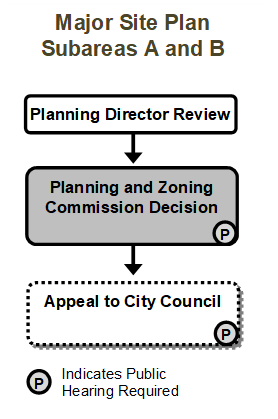
i. General. The Major Site Plan shall be approved only if:
(a) The application complies with the applicable standards in this UDO, other adopted City regulations, any approved Master Plan that includes the property, and any conditions specifically applied to development of the property by the Planning and Zoning Commission or City Council in a prior decision affecting the property.

(b) The City's existing infrastructure and public improvements, including but not limited to its water, wastewater, street, trail, and sidewalk systems, have adequate capacity to serve the proposed development, and any burdens on those systems have been mitigated to the degree practicable.
(c) Major Site Plans shall be designed to preserve and protect natural areas, ridgelines, swales, natural landforms, water quality and wildlife habitat of riparian corridors, wetlands, and floodplains affected by the proposed development and to integrate those areas into site design where practicable.
(d) The application will improve or expand multi-modal connections with adjacent sites, neighborhoods, and urban centers.
(e) The application is compatible with surrounding uses in terms of size, scale and building façade materials.
(f) The application mitigates any adverse impacts on the surrounding area to the degree practicable.
ii. Additional Criteria in the MU-FB District.
(a) Multifamily residential uses shall provide appropriate amenities, including recreational facilities, pedestrian facilities, unique aesthetic features, and quality design.
(b) All listed uses shall have connections to a pedestrian system serving the neighborhood, Fitzsimons, and surrounding areas.
(c) Where abutting parcels of land exist under single ownership, no Site Plan shall be approved for any portion of such parcels until a Master Plan that includes all such abutting parcels has been approved.
(d) Normal maintenance or minor repairs do not need to conform to the building and site design standards in Section 146-2.4.5 (Mixed-Use -- Fitzsimons Boundary District (MU-FB)) except for the following:
(i) Replacement of 25 percent or more of a building's total façade area shall not be considered normal maintenance and repair work. Such improvements shall be considered a site modification and shall require that the entire building's façade open to public view be subject to the applicable design requirements of this Section.
(ii) Exterior painting and the replacement or addition of signs and awnings for any reason shall be considered site modifications and shall be subject to the applicable design requirements of this Section.
(e) Alterations or additions of less than 2,000 square feet to existing buildings for conforming uses shall conform to the building and site design standards in Section 146-2.4.5 (Mixed-Use -- Fitzsimons Boundary District (MU-FB)) as follows:
(i) New construction, replacement construction, and modifications to existing parking lots and landscape areas on sites with existing development shall comply with the applicable requirements unless prevented by existing physical site conditions.
(ii) Proposed changes to areas adjacent to street frontages shall require compliance with applicable right-of-way improvements, dimensional standards, and other development standards in this UDO.
(f) New buildings and alterations or additions of 2,000 square feet of gross floor area to existing buildings shall comply with the building and site design standards of Section 146-2.4.5 (Mixed-Use -- Fitzsimons Boundary District (MU-FB)).
iii. Additional Standards in MU-TOD District.
(a) Any new exterior construction or landscaping, or any exterior changes to existing development including changes to building façades, signage, streetscape, landscaping, public rights-of-way, parking areas, drives, or other Site Plan changes shall meet the building and site design standards of Section 146-4.8 (Building Design Standards) subject to the Touch Rule defined in Section 146-5.4.4.
(b) To allow greater intensity in the MU-TOD district over time:
(i) Buildings and surface parking (if allowed) shall be located on the lot so that the layout will accommodate future structured parking garages.
(ii) Drives within commercial parking lots shall be located so they can conform to urban street standards in the future.
(iii) Both sides of major pedestrian streets shall be developed to establish the streetscape character and pedestrian connections.
(iv) Important public parks and plazas shall be constructed in the initial phase of development to establish a public amenity and the area's identity.
3. Minor Site Plan.
a. Applicability. The Minor Site Plan procedures and criteria apply to applications for a permitted use in the zone district where the property is located if the application is not exempt from the Site Plan process pursuant to Section 146-5.4.3.B.1.a and the application is for one of the following:

i. Subareas A and B.
(a) A new commercial, mixed-use, civic, institutional and industrial development that includes a single primary building on a single lot or parcel that contains less than 10,000 square feet of gross floor area on the ground floor, compatible with the heights of buildings on abutting lots facing the same street right-of-way.
(b) A new residential development that contains six or fewer dwelling units.
(c) An expansion of existing multifamily, non-residential, mixed-use and non-residential properties, projects, or developments that increase the property, project, or development by less than 10,000 square feet of gross floor area.
(d) A project for which the primary use is listed in the Industrial use category in Table 3.2-1 (Permitted Use Table) and that is located at least 300 feet, measured radially, from a Residential zone district.
(e) Additional Standards for Redevelopment Plan/Adaptive Reuse. Notwithstanding the provisions of Section 146-1.4.3, standards apply to the reuse or modification of buildings that do not have existing site plans where such reuse or modification is within the limits of the “touch rule” described in Section 146-5.4.4. If there is conflict between the provisions of this section and Section 146-5.4.4, the provisions of this section shall apply. Applications for reuse or modifications beyond the limits of that touch rule are considered new construction and shall comply with all standards applicable to new construction rather than the standards in this section.
Additionally, the following standards apply for a redevelopment plan/adaptive reuse:
(i) The proposed adaptive reuse must be a permitted use or must be approved as a conditional use in which the building is located, as shown in Table 3.2-1 (Permitted Use Table).
(ii) Purpose. The purpose of these adaptive reuse standards is to encourage and facilitate the reuse of existing buildings that are underutilized or underperforming by modifying site development standards that would otherwise make the reuse of existing buildings, structures and sites impracticable. Enhancements to the exterior of an adaptive reuse building should focus on elements that improve ground floor design of the building. Ground floor designs should support a pedestrian-friendly environment, define the main entry, provide visual interest and enhance the public realm.
(iii) Setbacks. Any additions or façade changes involving greater than 25 continuous linear feet of exterior wall facing a public right-of-way shall comply with zoning setbacks.
(iv) Height. The heights of buildings existing on the effective date shall be exempt from building height limits established by Section 146-5.4.4 or Section 146-4.2 (Dimensional Standards). The addition of parapets or roof structures, equipment or other enclosures or nonhabitable space is allowed. Any new or additional habitable spaces or floors shall comply with the height limits established in the zone district where the property is located.
(v) Design Standards. When an adaptive reuse project includes the alteration, reconstruction or remodeling of the exterior walls or façades of a building, the design standards shall apply to the façades being altered or reconstructed to the maximum extent practicable.
(vi) Access and Infrastructure.
(a) Existing access points and driveways may remain in use.
(b) Developments with access on CDOT Highways will be referred to the Colorado Department of Transportation (CDOT) for review, and a CDOT access permit will be required prior to construction in the CDOT right-of-way.
(c) Sidewalks adjacent to an adaptive reuse project shall be improved to the maximum extent practicable.
(d) Adaptive reuse projects shall provide site furnishings, sidewalks, landscaping, screening and lighting to the maximum extent practicable.
(vii) Landscaping.
(a) Dead or missing landscaping in designated landscape areas existing before the effective date shall be replaced or installed as part of an adaptive reuse project.
(b) Trees and other landscaping shall be provided in tree openings, tree grates, planters or planting beds along the adjacent street frontages to the maximum extent practicable.
(c) Where the scale or character of the proposed adaptive reuse differs significantly from the scale and character of development on abutting properties, as determined by the Director, the Director may require the installation of fences, walls, or vegetation to mitigate impacts of the proposed adaptive reuse on the abutting property to the maximum extent practicable given the size and dimensions of the adaptive reuse property.
(viii) Parking.
(a) Additional parking spaces shall not be required for an adaptive reuse project; provided, that any existing on-site parking spaces are not removed, or unless the existing parking spaces to be removed are not needed to meet the minimum parking standards of Section 146-4.6.
(b) The location of new parking areas for an adaptive reuse project shall comply with Section 146-4.6.5.A (Location and Use of Parking Facilities) to the maximum extent practicable.
ii. Subarea C. All applications that do not include Major Adjustments, and that do not require Major Site Plan review.
b. Procedure. The Planning Director shall review and make a decision on the application.
c. Criteria for Approval. The Minor Site Plan shall be approved only if the application complies with the applicable standards in this UDO, other adopted City regulations, any approved Master Plan that includes the property, and any conditions specifically applied to development of the property by the Planning and Zoning Commission or City Council in a prior decision affecting the property. If the application does not comply with those standards, the Planning Director will notify the applicant of what other permits, approvals, or changes to the application are required for compliance.
C. Floodplain Development Permit. Any property required to obtain a Floodplain Development Permit pursuant to Chapter 70 of the Aurora City Code shall obtain such permit before a building permit may be issued by the City.
D. Historic Landmark/District Development Application. All applicable provisions of Section 146-5.3 (Common Procedures) apply unless specifically modified by the provisions of this Section 146-5.4.3.D.
1. Applicability. No person shall carry out or cause to be carried out any construction, alteration, removal, or demolition of a building or feature or make any changes that would impair the historic association of the landmark building, landmark site, or historic district, or take any action that would create indirect impacts on historic resources, such as impairment of the view corridor or historic context of the structure, pursuant to those qualities identified in Section 146-5.4.3.D.3, without first obtaining a permit pursuant to this Section 146-5.4.3.D.
2. Procedure.
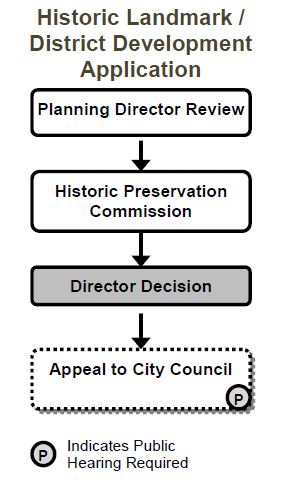
a. Applications for application approval shall be submitted to the Historic Preservation Commission through the preservation specialist and shall contain the information required by the Commission's rules of procedure and bylaws. The Commission's preservation specialist shall determine whether the request constitutes "major" or "minor" changes in the landmark or district.
b. If an application is received for an application or a request to carry out any new construction, alteration, removal, or demolition of a building or other designated feature on or in a landmark property, site, or district for which landmark designation, zone change, or development plan is pending, the application shall be forwarded to the preservation specialist and Historic Preservation Commission within 10 working days.
c. The Planning Director shall reserve the right to review and comment on recommendations for historic preservation activities prior to any decision by the Historic Preservation Commission.
d. No application shall be approved or request granted before comment has been received from the Historic Preservation Commission.
e. Commission comment shall be made within 60 calendar days of receipt of the request or application.
f. After receiving the Commission’s comment, the Planning Director shall continue processing the Development Application pursuant to Section 146-5.4.3.B.
3. Criteria for Approval.
a. The Historic Preservation Commission shall consider the following in reviewing applications affecting historic landmarks, sites, or districts:
i. For applications pertaining to landmarks and landmark sites, the proposed work shall preserve, enhance, or restore the exterior architectural features of the landmark. The proposed work shall not adversely affect the special character or special historical, architectural, or archaeological nature of the landmark or its site.
ii. For applications pertaining to property in historic districts, other than on a designated landmark site, reasonable efforts shall be made to preserve, enhance or restore, and not to damage or destroy, the exterior architectural features of the subject property. The degree of compatibility and the character of the historic district, the feasibility of rehabilitation, and other pertinent factors shall be considered in the preservation efforts. New construction, remodeling, or other proposed exterior changes to a structure shall be compatible with the character of the historic district as described in the designating ordinance, particularly with reference to scale and materials. An application for a building permit or new construction must be approved if such compatibility exists.
iii. The commission shall seek compatibility of structures in the district in terms of size, texture, scale, and Site Plan. The Secretary of the Interior's Standards for Rehabilitation and Guidelines for Rehabilitating Historic Buildings shall be considered by the commission in passing applications for any application.
E. Temporary Use Permit. All applicable provisions of Section 146-5.3 (Common Procedures) apply unless specifically modified by the provisions of this Section 146-5.4.3.E.

1. Applicability. This Section applies to applications for any use listed as a temporary use in Table 0-1 (Permitted Use Table).
2. Procedure. The City Manager’s Office and City Clerk shall review and make a decision on the application.
3. Criteria for Approval. A Temporary Use Permit shall only be approved if the Planning Director determines that the following criteria are met. If the applicant requests that the duration of the permit be extended beyond the maximum time permitted by this UDO or the terms of the initial permit, the extension shall only be approved if the Director receives the request for extension before the expiration of the initial permit and determines that the following criteria are still met:
a. It is for one of the uses listed in Table 3.2-1 (Permitted Use Table) as a temporary use permitted in the zone district where the property is located or:
i. The proposed temporary use is a temporary Telecom Facility on private property that does not create an obstruction or hazard to the public right-of-way, above ground utility lines, or protected airspace in which case the permit may be issued for a period not to exceed 14 consecutive days. A longer period may be authorized only upon a finding by the Planning Director that such longer period is needed to address an emergency situation.
ii. An annual permit has been issued to a licensed individual vendor for a temporary outdoor food and/or merchandise stand. Vending will be permitted pursuant to Section 146-3.3.6.R (Temporary Outdoor Food or Merchandise Stand).
b. The application complies with the applicable standards in this UDO and other adopted City regulations and, including but not limited to any use-specific standards for the proposed temporary use in Section 146-0, unless an adjustment of or variance from standards is approved under Section 146-5.4.4.
c. Approval of the application or request for extension of a Temporary Use Permit will not result in the use of any portion of the property for unenclosed or enclosed storage of goods, materials, equipment, or vehicles for a period longer than 12 consecutive months (including any periods permitted by prior Temporary Use Permits.
d. The applicant has submitted a cash deposit in the amount specified in the schedule of fees. Such deposit shall be returnable at the conclusion of the proposed activity provided that the site of the proposed activity is returned to its original condition within 24 hours after the last day of the permitted use. If it is necessary to initiate cleanup operations because of trash, garbage, or debris attributable to the proposed activity, the cost of such cleanup operation shall be deducted from the cash bond. Nothing in this Section shall prohibit the City from commencing appropriate legal proceedings against the applicant if the cost of cleanup operations exceeds the cash deposit.
e. The issuance of the permit will not endanger the public health, safety, or welfare.
f. If any adjustment of standards in this UDO or waiver or adjustment of adopted City standards outside of this UDO related to sanitary facilities, adequate water supply, additional fire protection measures, traffic control measures, liability insurance, or cleanup bond has been requested by the applicant, the Planning Director shall consult with the relevant City departments and determine that the requested waiver or adjustment will not endanger the public health, safety and welfare and will not injure the appropriate use of adjacent conforming property.
F. Creative Sign Program. All applicable provisions of Section 146-5.3 (Common Procedures) apply unless specifically modified by the provisions of this Section 5.4.3.F.

1. Applicability. Any property owner or business owner in the City that is not otherwise subject to an approved privately enforced sign program is eligible to apply for a creative sign application.
2. Procedures. The Planning Director shall review and make a decision on the application.
3. Criteria for Approval. An application for a creative sign program shall be approved if the Planning Director determines that it meets the following criteria:
a. Architectural Criteria.
i. The sign(s) uses or enhances the architectural elements of the building;
ii. The sign(s) are placed in a logical location in relation to the overall composition of the building façade;
iii. The sign(s) are integrated within and do not cover any key architectural features and details of the building façade; and
iv. The sign is not larger than 100 square feet.
b. Wall Signs.
i. Wall signs are centered within an area uninterrupted by doors, windows, or architectural details.
ii. Each sign is designed to be compatible with and relate to the architectural style of the main building or buildings upon the site where the sign is located.
iii. The color(s) of a sign are harmonious and complementary to the colors of the building on or near which it is to be located.
c. Design Quality. The sign(s):
i. Constitute a substantial aesthetic improvement to the site and have a positive visual impact on the surrounding area;
ii. Be of unique design, and exhibit imagination, inventiveness;
iii. Provide strong graphic character through the imaginative use of graphics, color, texture, quality materials, scale, proportion and form; and
iv. Contribute to the image of the City by conveying a distinctive character that conveys a strong sense of place.
d. Illumination. The sign(s) use of back-lit or reverse channel letters or message content with halo illumination rather than internally-lit signs where possible.
e. Multiple Signs. Where more than one sign is proposed, all signs a have designs that incorporate the following design elements in a compatible and coordinated fashion:
i. Letter style of copy; components;
ii. Type of construction materials;
iii. Lighting; and
iv. Method used for supporting sign (e.g., wall or ground base).
f. Neighborhood Impacts. The sign(s) shall:
i. Be located and designed not to create adverse impacts on neighboring uses;
ii. Constitute a substantial aesthetic improvement to the site and have a positive visual impact on the surrounding area; and
iii. Provide strong graphic character through the imaginative use of graphics, color, texture, quality materials, scale, and proportion.
g. Sign Materials. The sign(s) maintain attractive and compatible styling so as not to conflict or distract from the architectural character of the area, and the choice of materials and the workmanship in the use of the materials conveys both a sense of quality and creativity.
G. Sign Permit. All applicable provisions of Section 146-5.3 (Common Procedures) apply unless specifically modified by the provisions of this Section 146-5.4.3.G.
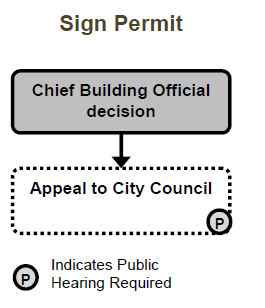
1. Applicability.
a. No person shall erect, move, re-erect, construct, alter, enlarge, or allow the erection of any sign without first obtaining a Sign Application.
b. No application is required for text changes or changes to the visual content or message on a sign if no structural physical design, sign area, type of sign, or other changes are made.
c. The applicant may seek prompt judicial review of any denial of a sign application pursuant to Rule 106 of the Colorado Rules of Civil Procedure.
2. Procedure. The Chief Building Official shall review and make a decision on the application within 30 calendar days after receiving a complete application.
3. Criteria for Approval. A sign application shall be approved only if:
a. The application complies with all applicable standards for that type(s) of sign in Section 146-4.10 (Signs).
b. The applicant is a contractor licensed by the City. No person other than a sign contractor licensed by the City shall obtain any sign application or install any sign (other than a temporary sign) for which an application is required by this UDO.
c. The property does not contain any illegal signs. No sign application may be issued to a business where any illegal signs are currently displayed in violation of this UDO, except to replace an illegal sign with a legal sign.
H. Fence Permit. All applicable provisions of Section 146-5.3 (Common Procedures) apply unless specifically modified by the provisions of this Section 146-5.4.3.H.
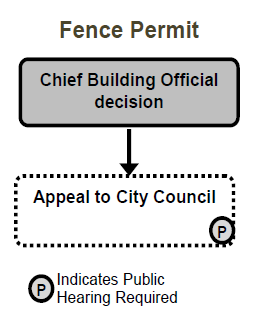
1. Applicability. This Section applies to all applications to construct or modify a fence or wall for which a building permit is required by the City.
2. Procedure. The Chief Building Official or other City official so designated by the City Manager shall review and make a decision on the application.
3. Criteria for Approval. The application shall be approved if the application complies with the provisions of Section 146-4.7.9 (Fence and Wall Regulations), and other adopted City regulations.
I. Administrative Activity Center Designation. All applicable provisions of Section 146-5.3 (Common Procedures) apply unless specifically modified by the provisions of this Section 146-5.4.3.I.
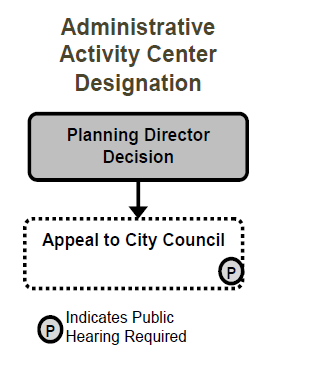
1. Applicability. This section applies to all requests by an owner of land located in Subarea C to designate portions of lands zoned R-1 or R-2 so they may be developed pursuant to those UDO regulations applicable to the MU-N or MU-C zone districts.
2. Procedure. The Planning Director shall review and make a decision on the request.
3. Criteria for Approval.
a. The requested land in Subarea C zoned R-1 or R-2 shall be designed to allow development pursuant to those standards applicable to the MU-N zone district, and the City shall indicate that designation on a map where the designation can be viewed in relation to zone district designations, if the Planning Director determines that:
i. The land area is located at the intersection of two platted collector streets or at the intersection of a platted arterial street and a platted collector street; and
ii. The land area is less than ten acres in size; and
iii. The land is not located within one-half mile of another site in Subarea C that is zoned MU-C or designated for development pursuant to MU-C zone district standards, as measured along either of the arterial streets; and
iv. The land is not located within one-quarter mile of another site in Subarea C that is zoned MU-N or designated for development pursuant to MU-N zone district standards, as measured along either the arterial or collector street.
b. The requested land in Subarea C zoned R-1 or R-2 shall be designated to allow development pursuant to those standards applicable to the MU-C zone district, and the City shall indicate that designation on a map where the designation can be viewed in relation to zone district designations, if the Planning Director determines that:
i. The land area is located at the intersection of two platted arterial streets; and
ii. The land area is less than 40 acres in size; and
iii. The land is not located within one-half mile of another site in Subarea C that is zoned MU-C or designated for development pursuant to MU-C zone district standards, as measured along either of the arterial streets;
iv. The land is not located within one-quarter mile of another site in Subarea C that is zoned MU-N or designated for development pursuant to MU-N zone district standards, as measured along either of the arterial streets.
4. Post Approval Action. If the owner of land that has been designated for development pursuant to as MU-N or MU-C zone district standards pursuant to this Section 146-5.4.3.I and (a) has not begun development of some or all of those lands, and (b) has not obtained approval of a final subdivision plat for development of surrounding lands for duplex residential dwellings, attached single-family residential dwellings, or multifamily dwellings, the owner may file an application to vacate or modify the Master Plan or Site Plan to exclude some or all of those lands from eligibility for development pursuant to MU-N or MU-C zone district standards. Upon receipt of such an application, the Planning Director shall confirm that no development pursuant to the MU-N or MU-C zone district standards has occurred on the land proposed to be excluded, and if so, shall approve the application to redesignate the requested portion(s) of the property back for development pursuant to R-1 or R-2 zone district standards (whichever applied prior to the MU-N or MU-C development designation), and shall revise the map referenced in Subsection 3 above to reflect that change.
J. Commercial Mineral Designation. All applicable provisions of Section 146-5.3 (Common Procedures) apply unless specifically modified by the provisions of this Section 146-5.4.3.J.
1. Applicability. This section provides a procedure to comply with the requirements of C.R.S. § 34-1-301 et seq. "Preservation of Commercial Mineral Deposits," in which the General Assembly declared that the preservation of access to commercial mineral deposits are matters of concern in the populous counties of the state, and restricted development approvals inconsistent with the removal of commercial mineral deposits.
2. Procedure.
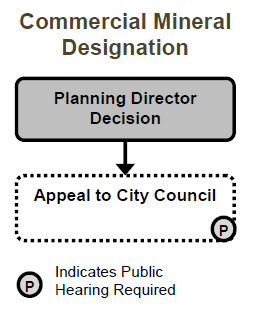
a. The owner of a mineral resource may apply to the Planning Director to have the resource designated as a "commercial mineral deposit."
b. Notice of the application shall be given to the surface owner, if the mineral interest has been severed from the surface estate.
c. The Planning Director shall review and make a decision on the request.
3. Criteria for Approval. A mineral resource shall be designated as a commercial mineral deposit only if Planning Director determines that the definition of a commercial mineral deposit in C.R.S. § 34-1-301 et seq. has been met and all of the criteria in Section 146-Error! Reference source not found. (Error! Reference source not found.) are established by the evidence presented.
4. Post Approval Action. Following the designation of commercial mineral deposit, no use of any area containing a designated commercial mineral deposit shall be permitted in a manner that would interfere with or permanently preclude the extraction of the deposit by an extractor. Written notice of an application for zoning or subdivision of land within an area containing a commercial mineral deposit shall be provided by the applicant to the owner of the underlying mineral interests. (Ord. No. 2021-15 §§ 27, 28, 06-14-2021; Ord. No. 2020-37 §§ 33 – 36, 10-05-2020; Ord. No. 2019-49 § 1, 08-19-2019)